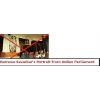Remove the Portrait of Savarkar from Indian Parliament Now
Petitioning: India, Sign this Petition to bring Solidarity.
Petitioner: Campus Front started on January 31, 2013
Savarkar underwent a serious metamorphosis during his years in jail in the Andamans between 1911 and 1921. He subjected himself to the British and pleaded clemency on their conditions and agreed to give full co-operation to them. Many documents to this effect are available in the national archives. He also worked against Gandhi and the Indian National Congress, which were the symbols of Indian national movement of indian freedom struggle.
The conditions in the prison of the Andamans were no doubt harsh but not a few patriots faced it courageously. But Savarkar was not one among them. He appealed for clemency, first in 1911 and then again in 1913 , the latter during the visit of Sir Reginald Craddock. In a letter dated November 14, 1913 Savarkar (convict no. 32778) wrote to the home minister of Britsih Government.
Savarkar's letter stated - “If the government in their manifold beneficence and mercy release me, I for one cannot but be the staunchest advocate of constitutional progress and loyalty to the English government which is the foremost condition of that progress […] Moreover, my conversion to the constitutional line would bring back all those mislead young men in India and abroad who were once looking up to me as their guide […] The Mighty alone can afford to be merciful and therefore where else can the prodigal son return but to the parental doors of the government†.
In response to the petition, the British Government released him under the condition that he will stay in Ratnagiri district and will seek the permission of the British government to leave the district and also that he will not engage in any public or private political activities without the consent of the government.
In 1920 Gandhi wrote in Young India about Savarkar’s attitude towards the British: “They [the Savarkar brothers] both state unequivocally that they do not desire independence from the British connection. On the contrary, they feel that India’s destiny can be worked out in association with the British†. Thus Savarkar ‘forfeited’ his claim to be a revolutionary freedom fighter and bartered the country’s independence to obtain his own personal freedom. This act of surrender to the British alone is sufficient to obliterate all the revolutionary feats attributed to him by his contemporary followers.
How can be Savarkar a Freedom Fighter, A potrait of Savarkar in Indian Parliament is Insult to Mahatma Gandhiji and to India.
Campus Front of India Demands Removal of Savarkar's protrait from Indian Parliament.
References:
A.G.Noorani observes that it took the Sangh Parivar long to own up Savarkar. The Jan Sangh never spoke of him or of Hindutva from 1951-1977. The BJP, formed in 1980, took up Hindutva only in 1990 and Savarkar in 2000, through Atal Behari Vajpayee. See A.G.NOORANI, “Savarkar and Gandhiâ€, 36.
A.G.Noorani says that the unveiling of Savarkar’s portrait in Parliament House on 26 February 2003 shows that Hindutva ideologues are prepared to stoop very low in order to accomplish their sordid ends. It will replace the national ideology of secularism with Hindutva and the national hero Gandhi as the Father of the nation, with Savarkar. See A.G.NOORANI, “Savarkar and Gandhiâ€, 36.
A.G.Noorani says that Savarkar was brought to the Andamans on 4 July 1911. Before the year ended he sent his first petition for clemency. See A.G.NOORANI, “Savarkar and Gandhiâ€, 35.
But these were not all. A.G.Noorani observes that Savarkar has a sustained record of abject apologies. He says: “Which other freedom fighter has so sustained a record of abject apologies and undertakings?. They were given in 1911, 1913, 1925, 1948 and 1950. The last was given in the Bombay High Court on July 13, 1950 to secure release from preventive detentionâ€. A.G.NOORANI, “Savarkar and Gandhiâ€, 36.
From the facsimile of Savarkar’s letter, Frontline, 7 April, 1995. Emphasis added.
R.C.MAJUMDAR, Penal Settlement in Andamans, 213. For the complete text of Savarkar’s mercy petition dated 14 November 1913 see Mainstream 25 September 2004, 14-15.
For a detailed account of Savarkar’s escape and capture and the judicial procedure which followed between the French and the British see File 847 V.D.Savarkar; arrest and extradition, escape and recapture at Marseilles (18 March – 7 October 1910), L/P&J/6/994, India Office, British Library, London; File 359 Savarkar case; Cases, Counter Cases and Replies, etc (15 December 1910-10 March 1911), L/P&J/6/1060, India Office, British Library, London; File 778 Savarkar Case, trial and conviction, question of extradition in the case of failure at the Hague (9 December 1910-23 February 1911), L/P&J/6/1069, India Office, British Library, London; File 1131 Savarkar Case; Proceedings at the Hague (including result) (28 January - 21 April 1911), L/P&J/6/1077, India Office, British Library, London.
Refernces are from Internet research any discrepany in the information "Campus Front of India will not be liable for the misinformation.






